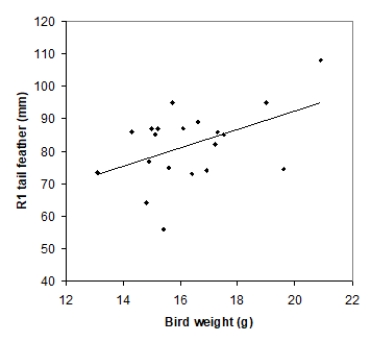Multiple Choice
Tail-feather length in birds is sometimes a sexually dimorphic trait; that is, the trait differs substantially for males and for females of the same species. Researchers studied the relationship between tail-feather length (measuring the R1 central tail feather) and weight in a sample of 20 male long-tailed finches raised in an aviary. The data are displayed in the scatterplot below, followed with software output about the least-squares regression model of feather length as a function of weight.
\begin{array}{l}\begin{array} { l l r } \hline &\text {Coefficients }&\text {Standard Error }\\\hline\text {Intercept }&35.7379 & 21.0523 \\\text { Bird-weight}&2.8299 & 1.2811\\\hline\text {R Square }&0.2133\\\text {Standard Error }&\ 10.5270\\end{array}\end{array} We want to test the hypotheses H0: β = 0 versus Ha: β > 0, where β is the true value of the population slope. What is the P-value for this test?
A) Less than 0.01
B) Between 0.01 and 0.05
C) Between 0.05 and 0.10
D) Greater than 0.10
Correct Answer:

Verified
Correct Answer:
Verified
Q35: Tail-feather length in birds is sometimes
Q36: The slope βof the population regression line
Q37: Researchers examined hormonal changes in 39
Q38: Tail-feather length in birds is sometimes
Q39: A fisheries biologist has been studying
Q40: Researchers want to know if reading
Q42: A researcher from the crop and
Q43: A random sample of 79 patients
Q44: Tail-feather length in birds is sometimes
Q45: Data on the water quality in